14 Powerful Psychology Hacks in Social Media Marketing To Boost Your Engagement
Feeling like your social media engagement is low?
Want to make your audience more engaged so that they engage and interact with you and your posts on social media?
As social media gets more and more saturated, the competition for getting seen increases. We’ve seen the organic reach drop close to zero on Facebook, we’ve seen the organic reach drop dramatically on Instagram.
As more and more content is put out on social media, people will be less likely to engage with just your post.
You are trying as hard as you can to increase your engagement, but nothing seems to help.
Engagement is crucial for social media success because it is when your audience interact with you that you can have the greatest effect on them. If they’re just following you, they won’t do much good for your brand, right?
If you look up ways to increase your engagement, you’ll find a lot of answers. Some are great, and some, well, not so great.
But most of the tricks and tips you’ll find will be shallow, and more like hacks that convince your audience to engage with your post.
But today, we’re looking at something different.
In this post, I am going to the very bottom of engagement and human interaction to find out what really triggers us humans, and how we can implement that into social media to boost results.
Interesting, right?
It is when you understand how the human works that you can use that to your advantage on social media, and marketing in general.
And when you do, you’ll have a leverage over many of your competitors that haven’t realized this yet.
Ready to get a leverage over your competitors and boost your engagement on social media with psychology?
Good, let’s dig right in.
1. Create a lot of Positive Traits For Your Brand
This method is very interesting because it shows how us humans think.
This method is also called the halo effect and isn’t really a method, but more so, it takes place no matter if try to steer the effect to benefit you or not.
”The halo effect is a cognitive bias in which we judge someone’s opinion based on our overall impression of him or her.”
The halo effect impacts us humans and convinces us to believe that a person (or brand) carries negative or positive characteristics. This, in turn, means that the unknown qualities of the brand or person will be either positive or negative.
In other words, if I only know you very briefly, and only know 5 of 10 of your qualities of you, and I have a positive view on those characteristics, the halo effect will make those unknown qualities positive. This means that the halo effect will make people’s view of you consistent. It won’t be something in between positive and negative. It’s either or.
The idea is that if a brand or person has positive characteristics and traits, people will view you as positive. And if you have negative traits, people will see you as negative!
And what can we learn from this?
´Well, it is important that you build a lot of positive traits for your brand so that the halo effect gives people a positive view of your brand. And what happens when people have a positive view of your brand? They are far more likely to engage with you, of course!
Positive traits can be virtually anything that is appreciated by your audience and that brings them value. For example, if you give away a car to your audience, that is classified as a positive trait.
Now, obviously, you don’t have to give away a car to build a positive trait. It can be enough to just write a personal message thanking them for their support.
When you build your positive traits, people will become more positive towards you, and see the value that you are providing them, whether it be with your products or your content on social media.
2. Leverage Social Proof
Social proof is probably the most well-known psychology hack for better marketing results, not only on social media but everywhere.
People know that social proof boosts results in marketing, because, well, just look at these statistics:
70% of consumers say they look at product reviews before making a purchase
Product reviews are 12x more trusted than product descriptions from manufacturers
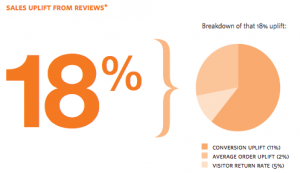
Site visitors who interact with both reviews and customer questions and answers are 105% more likely to purchase while visiting and spend 11% more than visitors who don’t interact with UGC. (Bazaarvoice, Conversation Index, Q2 2011).
They speak quite clearly.
While social proof is great for driving sales, it can also be great for boosting your social engagement.
Social proof is simple. It means showing people that a lot of other people are doing (or have done) what you plan on doing, which ultimately makes people believe that doing so is the ”norm” and that you are weird if you don’t do it.
Social proof can be anything that leverages the opinions and actions of a large collection. It is essentially the phenomenon that has us follow the herd.
Have you ever walked around looking for a restaurant and then chosen one with a lot of people in it, shying away from the one with just a few people?
It’s a perfect example of social proof.
Even if the restaurant with a lot of people in it might take a long time to deliver food, you still chose it because there was a lot of people in it, right?
Therefore, the food must be good. right?
Well, not necessarily, but us humans are wired that way, so we believe that if everyone else is doing something, you should be doing it too. This touches briefly on the fear of missing out, or more so, being left out of the group from when we were hunters.
If you did as everyone else did, you would do just fine, but if you went your own way, not so sure. With social proof, you expect the herd to know best, and possess most knowledge about something, and, therefore, you do as everyone else is doing because you expect that to lead you to the best choice.
There are many ways to leverage social proof in marketing, and whether you think about it or not, you are seeing it everywhere.
What happens if you visit Socialmediaexaminer.com?
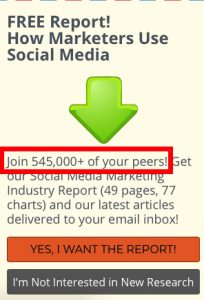
You have their pop up show up, which leverages social proof.
Because 545K+ other people have downloaded it, it must be good, right?
What’s more, they also leverage the power of belonging, but more on that later.
Social proof has existed for a long time, but in recent times, more and more marketers have started to realize the power of it in social media.
There are several ways you can leverage social proof to boost your engagement.
A tremendously powerful way of boosting your engagement on social media is to incorporate social share counters on your website. If you’ve been advertent, you’ve probably seen that a lot of websites have these incorporated. Instead of just having a social share button, the number of people will be displayed. And if a lot of people have shared something, more people will be convinced to do it as a result of social proof.
The flip side is that unless you have any social shares, it won’t be very convincing.
Another example of using live share counters is Neil Patel. Not only does he have a bar to the left that follows you along as you’re reading, he also has share buttons at the bottom of the article once you’ve finished reading.
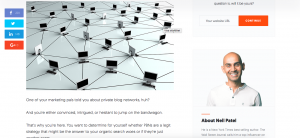
When choosing social share buttons, you want to limit yourself to a few. Patel could have chosen to use all of them on his website, but instead, he chooses just to have 4. That is because if the user has too many options, it will paralyze and confuse them, leading them to not sharing on any platform.
There are many other ways, apart from displaying share buttons on your website to boost engagement. The most obvious one is to actually get a lot of engagement on your post.
Seems reasonable, right?
Just like you would choose to go to a restaurant that has a lot of people rather than a restaurant that is almost empty, you are more likely to engage with a post that already has lots of engagement instead of one that has zero comments and ten likes. This is called the wisdom of the crowd.
If a lot of people has engaged with a post, it must be popular, right?
This means that you have to do everything in your power (except buying fake engagement) within the first 10 minutes of you sharing your social media post, because that in turn, will lead to more engagement.
To learn the methods of increasing engagement, take a look at this post:
Another way of boosting your engagement on social media with the help of psychology, more specifically social proof, is to use influencers and famous people to promote you. More on that in the next point.
What’s more, you can also leverage positive reviews from the past in your post. If you can, use a review that refers to your engagement, so that the review is focusing and encouraging people to engage with your post. For example ”Your brand is always super kind and helpful! They always respond within a few minutes after I’ve engaged with them on social media”.
However, if you’re going to use social proof in the form of reviews and testimonials, you need to make sure that you actually live up to the reviews that you share.
3. Use Influencer Marketing
Influencer marketing has a tremendous marketing power, and a well set up campaign can drive impressive results, we know that. Just take a look at these impressive influencer marketing statistics:
Okay, that influencer marketing can drive impressive results is not really any news, but that’s not what we’re going to use influencer marketing for this time.
Instead, we’re going to focus on influencer marketing as a way to build social proof.
Since I’ve talked quite a lot about social proof already, I won’t dig into it too much, however, what will do is tell you why influencers are so effective in building social proof for boosting engagement – and ultimately driving sales.
The key here is to leverage the credibility of influencers, in order to gain more exposure, engagement, and ultimately your audience’s trust.
People who follow influencers trust them. This means that when the influencer gives tips, their audience is highly likely to listen. Therefore, when they recommend your brand, a lot of people will listen, and they’ll trust the words of the influencer. The best part is that, while brands will never even come close to holding the trust that influencers hold, some of the influencer’s trust will be transmitted to you.
And as a brand, having your audience’s trust is one of the most valuable things. However, whatever you do, make sure that you don’t do anything that makes you lost their trust once you’ve got it.
Remember that trust takes a long time to build but a short time to destroy.
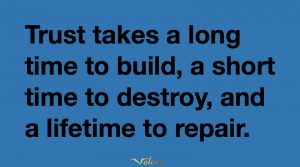
Another reason that influencer marketing works is because of the halo effect that I just spoke about. And the truth is that it applies to influencer marketing as well.
This means that since people are actively looking up influencers, they care about what they have to say, resulting in people actually listening to what the influencer is saying.
Lastly, people listen so much and are influenced by the words of an influencer because of the concept of egoism, where people are subconsciously like things that resemble themselves in one way or another. And what’s interesting about this is that people often liken themselves with the influencers they follow and look up to, and maybe, that is the reason that they follow and look up to the influencer.
4. Give Your Brand A Personality
Establishing a personality for your brand is a crucial part of increasing engagement, but if you look at it from a broader perspective, I’d even dare to say that it is crucial for social media success.
Here’s why:
Humans build relationships with humans.
It’s very difficult to build a strong relationship with a fancy logo and brand name, is it?
When people engage with you, they improve their relationship with you, but the catch is that unless you’ll have a brand personality, they’ll have a hard time establishing a strong relationship with you.
Having strong relationships with your audience is to strive for. It is so beneficial for brands that it should be far up on your to-do list.
The thing is that when you build relationships with your audience, they build trust in you. And if people don’t trust you, they won’t buy from you.
What’s more, when people trust you, not only will they become more likely to buy, but they’ll also be more likely to actually listen what you have to say.
The good news?
As mentioned, humans build relationships with humans. That’s just the way it is.
And what it is humans have that many brands don’t?
A personality.
What if your best friend wouldn’t have a personality?
Chances are, they wouldn’t be your best friend.
Nobody wants to interact with a person that is emotionless, opinionless, and personality-less.
It’s just hard! It makes the conversation shallow and boring, and even more importantly, it makes it almost close to impossible to build a strong relationship with you.
When your audience engages with you, it’s an opportunity for you to establish strong relationships with them, which ultimately leads to more trust. But first, to be able to do so, you need to give your brand a personality.
If there’s one brand that has dared to go their own way on social media when it comes to building a personality, it is Wendy’s.
They’ve built a sassy, very unique, and quite a controversial personality on social media, but still, it works! That’s because they know their target audience and that they resonate with their personality.
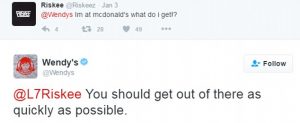
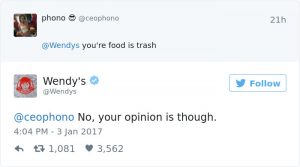
A study found that people have an easier time resonating with and identifying themselves with people that are more human-like, which isn’t very surprising, really. In other words, having a face and a personality to your brand will do a lot to your engagement and ultimately relationships.
The good news is that people are more likely to buy from people they like, and the first step to getting people to like you is to engage with them and build a relationship with them.
There are many ways to build your brand’s personality other than just having a personality when writing.
One way is to share photos of your team so that people realize that you are not just a logo and a brand and that there are actually real people behind it, just like themselves.
Another way is to sign every message you send, and every response you give with your name. Since people have an easier time resonating with humans, it will make it easier by giving them the name of the person they are talking to.
The punchline is that people have an easier time resonating with people, more correctly with people who have a personality. And unless you have a personal brand or a brand that is strongly tied to a person, you need to develop a brand personality to make it easier for people to resonate with you.
And when they can resonate with you, they are more likely to engage with you – not once, but regularly, as they start establishing a strong relationship with you. And when that happens, they’ll become loyal supporters and advocates of your brand that engage with every single post of yours.
To get started, you first need to develop a brand voice and brand message and then use it consistently. Remember that people normally don’t change personalities overnight. And if they do chances are that they’ll lose a lot of their relationships. And so will you.
Related:
- How to Improve Customer Relationships On Social Media That Boost Customer Retention
- 5 Ways to Build Valuable Relationships and Keep Your Audience Engaged with Social Media
5. Use Nostalgia
This is a psychological tactic that people aren’t using too much, especially not on social media, but still, it has many benefits for boosting your engagement.
Nostalgia has proven to have a great effect on us humans, it makes us remember something from the past, maybe from when we were kids. And this is also the reason to why nostalgia affects us so much. It makes us remember things from the past, and with that, a lot of memories are awakened, thus impacting us a lot.
Post that brings out memories bring out emotions, and if a post on social media can emotionally impact people. they are far more likely to engage with it.
As a result, you are missing out if you aren’t using nostalgia in your social media marketing – because it has a lot of power to impact.
According to Robert M. Brecht, Ph.D., “A variety of marketing research studies do indicate that the use of nostalgia in advertising does arouse attention, is entertaining, is persuasive, and evokes nostalgic reflections in consumers. Besides the positive emotions, they also induce mental images of former situations and experiences that are also positive in nature. One study indicates that when consumers experience nostalgia in a consumption context, they have a higher purchase likelihood with regard to the advertised products.”
It’s quite clear that using nostalgia impacts us humans, and can encourage and convince us to take actions. For you, this means to encourage them to engage with you on social media And when they engage with you, you increase their trust in you, which ultimately leads to sales.
This is why I dared to say that social media engagement and building relationships with your audience is the foundation to social media success.
6. Use Visual Content
Visual content has proven to have a great impact on us humans. In fact, it impacts us, humans, a lot more than text does, and it is able to convey a message much better.
Maybe, it is because of the fact that an image says more than a thousand words, and many people shy away from reading a thousand words, but not looking at it in the form of an image.
These statistics can help us understand just why visual content is so powerful:

There are tons of statistics that have been made that measure the correlation between the use of visual content on a website and its conversion rate. The results are quite remarkable. In fact, Bakker-Hillegom, a Dutch mail order company that sells plants, flower bulbs and garden accessories tried to incorporate more images to their website to get their visitors to stay longer, and to ultimately buy more, and the result was incredible. The information page with the two banner ads that they had created generated 104.99% visits to the “top deals page” and a statistical significance of 99.99%.
When creating visual content, you want to consider the fact that colors have a great psychological effect on us humans, which means that simply using the right colors can convince your audience on social media to engage with you.
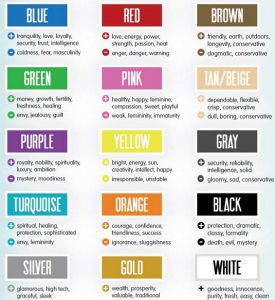
For example, the color blue denotes a sense of authority and can be used to cultivate the users’ trust. And by simply portraying your brand as trustworthy can encourage more people to engage with you.
Or, even better, using colors that send signals of kindness and warmth can make your brand approachable, thus making more people engage with you.
The good thing about images is that they grab attention a lot better than tex. By using images, you can get more people to stay and look at your post, and if you can get people to do, there’s a greater chance that people will engage with it.
7. Laugh With Your Followers
Evoking emotions in your audience is a great way to impact them and get them to interact with you. Of course, unless you are evoking anger at them because you have terrible customer
service.
Laughter greatly impacts your audience, and if you can get them to laugh as a result of you or your post, it will work as a glue to get them both more closely connected with you, but also more engaged in your brand.
The benefit of laughter is that it releases endorphins. When the endorphins are released, we become happier and more positive. And think of what that can for your brand when you’re the one evoking that!
Especially since you are the one that is right in front of them when they start to laugh.
What happens the is that they’ll get a more positive perception of your brand, and every time they’ll think of you, they’ll think about you positively.
There’s a but.
I mentioned that all feelings are good feelings, if you can evoke them from your audience with your posts, however, there’s one feeling that has proven to be more impactful and more effective and more contagious, and that is laughter. It has been found to be more contagious than the negative feelings you can evoke.
In fact, positive social media post generate an average of 1.75 more positive responses, while negative posts on social media only prompt 1.29. Therefore, evoking feelings, and most importantly making your audience laugh will have a great impact on your engagement rate.
Making your audience laugh through social media does not only have the benefit of making people remember your brand more positively. It also has many more benefits.
One of them is that posts with higher emotional value get higher shares on social media networks. In other words, social media posts that impact your audience and gets them to feel something, whether it is joy, sadness or anger (as long as it is not targeted towards your brand), your post will get more shares.
When you get someone to laugh at (or with) a social media post, many people will reward you with a social share, or at least a simple like.
Making your audience laugh through social media does not only have the benefit of making people remember your brand more positively. It also has many more benefits.
One of them is that posts with higher emotional value get higher shares on social media networks. In other words, social media posts that impact your audience and gets them to feel something, whether it is joy, sadness or anger (as long as it is not targeted towards your brand), your post will get more shares.
When you get someone to laugh at a social media post, many people will reward you with a social share, or at least a simple like.
Another huge thing you can use to your benefit is the so-called Baader Meinhof phenomenon, or in a more easily pronounced term: the frequency illusion. This phenomenon is essentially the fact that humans become more conscious of things, and tend to notice things more often if they are in some way related to that object.
Let’s say you plan on buying a new pair of shoes. As a result, you start looking at what shoes people are waring, and all of a sudden, you see the shoes everywhere, and it seems like everyone is wearing the same shoes as you plan on buying.
How can you benefit from this, you may ask?
Well, you can synthetically produce this effect, and get people to associate your brand with a particular feeling, as well as get them to think of your brand often.
To do so, you can show messages to your audience repetitively, and often, and when the frequency illusion starts working, every message you share will send positive signals to your audience.
A good way is to use retargeting and create social media ads to the people who have abandoned your website.
8. Use Social Reciprocity
Among all of these psychological behaviors that you can learn to use to your advantage to increase your engagement on social media, this is my favorite.
First off, let’s figure out what reciprocity even means. Wikipedia explains the word in the following way:

In the words, it means being kind to someone results in people being even nicer to you.
And if you are mean to someone, it means they’re going to be even meaner to you.
Of course, it doesn’t have to be that way, you can be as mean as you want – even if people are kind, however, reciprocity is a social rule that you should repay what another person has provided for you.
So how you use this in social media marketing and to boost your engagement?
Hold on, this is where it gets interesting.
The person that preaches most about this is Gary Vaynerchuk, but instead of calling it reciprocity, he calls it Jab, jab, jab, right hook, which he also names his book.
This translates to ”give, give, give, then ask”, and talks about how you can guilt someone into buying something from you by giving them so much value.
Take a look at this short clip of Gary Vaynerchuk explaining the matter:
The big part is that you are giving people value without expecting them to buy something.
There are tons of ways you can do this on, but the key to doing it is really finding what your audience finds valuable. It’s important that you don’t think that the only way to bring value s to give cold hard cash or gifts. In fact, If your audience is interested, giving knowledge, information, ideas, tips, suggestions, entertainment, a good laugh, etc, are all examples of ways to bring your audience value without having to give them cash or run giveaway.
However, that is not to say that you cannot or should not run a giveaway because that is also a great way to provide value to your audience.
Let’s say you are giving away a prize for a giveaway. When you do so, more and more people will engage with you! Not only because they actually want to join the giveaway and win the price, but also because they feel obligated to do so to thank you.
Therefore, contests and giveaways are great for boosting your engagement, because you’re actually guilting people into engaging with you. Interesting, right?
Obviously, you cannot run giveaways all day every day, but when people engage with you, you get the opportunity to respond and continue building your relationship with them.
The good thing about reciprocity is that it goes for interaction too!
If someone leaves a comment on your post, take your time to respond to it genuinely and really show that you value them. You know what happens when you do?
The person will see that you’ve put so much time into responding to their message that they’ll feel obligated to respond and take the time to do so.
And when they do, you have gotten the ball rolling, because it is interactions that is the best recipe for a high engagement, because interactions lead to loyal followers, and loyal followers lead to trust, and trust leads to sales.
Want to know the best part?
Reciprocity goes for virtually anything you can think of!
When we’re given something, we feel an urge, an obligation to return the favor.
This might be as simple as given a glass of water when inside a store, handed the newspaper, and so on.
The bottom line is that you should provide your audience value and make them feel special with random acts of kindness or by offering them exclusive discounts, gifts, and coupons.
9. Play On The Fear of Missing 0ut
If there’s something that humans are afraid of, it is missing out on something.
Psychotherapist, Philippa Perry described FOMO as “a modern take on the grass being greener on the other side.”
The good news is that you can leverage that in your social media marketing and for increasing your engagement.
You’ve probably missed out on things in your life that have caused FOMO – fear of missing out, and this isn’t something that is solely unique to you. No. in fact, the vast majority of people have fear of missing out more or less.
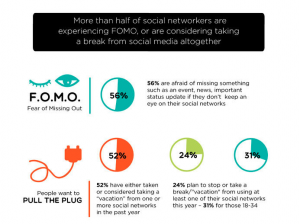
If you are a person that is greatly afraid of missing out, then you’re probably a person that has a hard time saying no, and get anxiety if you have to make a chose between one or another, because if you make the ”wrong” choice, you might be missing out.
Maybe have you in your life said no to your friends about going out and instead stayed at home, just to see that they are having the time of their life and felt terrible about it because you’re missing out.
It’s good to know that it is FOMO that feed people’s social media addictions. In fact, the main reason that people are addicted to social media is that they are afraid out on important news or updates.
FOMO is tremendously powerful because you can give your audience a promise about something, and then, people will return, because of fear of otherwise missing out.
But be careful when giving promises, though. If you give promises you cannot keep, you risk losing your followers’ trust forever.
You have probably read a ton of blog posts that have used the principle of FOMO when writing the title. Remember that nobody wants to be the only one who isn’t in the know, or who is missing a golden opportunity. And this is something you’re going to leverage on social media to get more engagement and better results.
If you want to sell things, and get people to take actions, here are some titles you can use:
- 50% OFF! only 15 t-shirts left!
- 25% OFF! Get them will they’re available!
- Only a few left, get them while you can!
All of these texts leverages the power of FOMO.
A great way you can boost your social media engagement is to ask your followers to turn post notifications on. Most social media platforms allow you to turn on post notifications so that each time the account makes a post, you’ll get a notification, you check out the post and then interact with it.
If you are sharing a blog post, for example, you can give it a different title when sharing it on social media, and create a caption that sparks FOMO. It can be, for example, ”10 things you need to do before you die”.
10. Create a Sense of Urgency
When you create a sense of urgency, you encourage people to act quick. Not to consider if they should do something and then forget about it. It’s about creating a feeling of now or never.
Creating a sense of urgency is very similar to the fear of missing out (FOMO), but the only difference is that creating a sense of urgency or more on time than the FOMO tactic is.
Just like FOMO, the tactic is about making people feel like they are about to miss out on something, but with the sense of urgency, they have to act quickly and do it now. Not wait until next week.
To evolve your FOMO offer and turn it into an offer with a sense of urgency, you need to make it very clear how much time people have. obviously, the less time people have, the more urgent it is, and the more likely they’ll be to do whatever you are hoping they are going to do.
The best way is to have a clock that is counting down, because then, the offer becomes much more concrete, and the whole situation gets much more stressful.
Of course, it’s difficult to do this on social media, so the best way is to let your audience know that it is a limited offer and that it is about to run out. When they get to your website, they are greeted by a clock that is ticking down and stressing them to start buying or doing whatever you want them to do.
The goal is to get your audience to react and act as soon as possible.
Another way to create a sense of urgency is to focus on the problems your product is solving, and the negative things that come if you don’t have your product.
For example, if you sell house alarms, you can start talking about the statistics of burglaries, and how the majority of houses which burglars break into don’t have an alarm. That way, you create a sense of urgency, because you frighten the customer about the problems that can happen if you don’t have your product.
Look at this sales page where a countdown clock creates a sense of urgency:

Or here, where they create the sense of urgency directly in the social media caption:

11. Spark Excitement by Promising to Spoil Secrets
Humans are terribly curious. For you, that’s a good thing!
That means that you can generate great results, grasp your audience’s attention, and get them to interact with you, if you succeed in sparking their curiosity.
When you give them A of something they have been wondering about, and you offer B on the other side, a large chunk of people will go to B just because they are curious to find out what it is.
In other words, give your audience limited information, for example in your social media post – enough to pique their interest and desire to find out what happens next, and then guide your audience to part B.
Or, if you’re creative, you can offer to send part B to everyone that engage with your post!
Win-win!
12. Work to Improve your Relationship With Your Audience
I’ve talked quite a lot about the importance of building relationships with your followers’ because strong relationships mean that people trust you, and they also have a bigger chance of becoming loyal advocates for your brand.
WHat’s more, when people trust you, they are far more likely to buy from you, because who buys something from someone they don’t trust?
I know I don’t!
Building relationships with your audience aren’t just important for social media success, but more so, social media allows you to engage with your audience and build relationships with people.
When you’ve built relationships, you want to start building your community. People like to feel like they’re part of something bigger, a group, a community. And that’s exactly what you’re going to give to them. When talking about this matter, I can’t help but bring up Abraham Maslow’s hierarchy of needs.
This is a psychological hierarchy pyramid that describes what humans need:
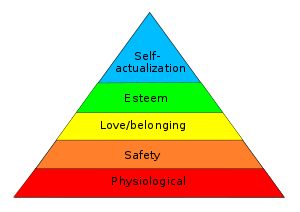
By being a brand that regularly engages with its audience, you can make your followers more loyal and supportive, thus resulting in a tight community. Where people are talking about you.
Building relationships on social media is an art, and so is building a community.
Here are some resources you can use to improve your knowledge and expertise.
13. Make Your Audience Part of Creating Something
Humans need to feel a connection. Just like I just talked about when it comes to building your community.
When you make your audience feel like they’re a part of something, they become more engaged in your brand and what you are posting.
Therefore, to engage your audience and make them a part of something, you want to make them a part of the creation process of something.
There are endless of ways of doing this, and only your imagination sets the limit, but one idea is to share a testimonial weekly on your social media from one of your followers. Doing this will not only make them a part of your content, but it will also show them that you value them and what they have to see.
Watch brand Daniel Wellington leverages this by incorporating photos on Instagram that has been shared with the hashtag #DwMoments to a page on their website.
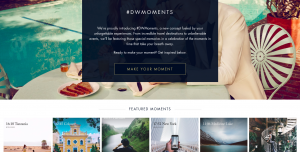
Doing this will make people feel more connected and engaged in the brand, leading to them becoming loyal supporters and fans.
14. Share Images of People
You now know that visual content has a great power compared to plain text.
But did you also know that photos with faces see a 38% increase in likes on Instagram compared to photos without faces?
It’s not strange if you think about it.
We are humans that resonate with humans.
But surprisingly, many brands and marketers ignore this. Some for better, and some for worse.
The conclusion is simple: the psychology of humans makes us resonate well with photos of humans, and if you re determined to gain more engagement on your social media, you better step in front of the camera, or, get someone to do it.
Be careful though with sharing selfies. If you’re a business, the majority of people don’t want to see your egocentric selfies. Instead, people like to see photos of your team and get an introduction to the people who make your brand possible.
Conclusion
Humans are rational creatures.
And if you understand how we work, and what drives us, we’re not that complicated really. In fact, we’re very predictable.
Understanding the psychology of humans is a huge leverage in marketing because it allows you to target people by reaching them with messages that truly impact and drive them.
By understanding the human psychology, you can better craft your messages to impact your audience on a deeper level, which ultimately leads to better results.


